
Domus Anatomica was an anatomical theatre which existed from 1644 until 1728 in Copenhagen, Denmark.

Domus Anatomica was an anatomical theatre which existed from 1644 until 1728 in Copenhagen, Denmark.
There are references to a modest lectorium medicorum in Copenhagen from 1605 but in 1621 the statutes of the university stressed that the construction of a proper theatrum anatomicum would be desirable. In 1639 Christian IV called Simon Paulli to Copenhagen from Rostock, appointing him professor of anatomy, surgery and botany, and Paulli, in 1643, took the initiative of converting one of the university's buildings overlooking Church of Our Lady's graveyard (later Frue Plads) into the new Domus Anatomica. The new institution was completed the following year although Paulli did not hold his first public lecture until 3 March 1645. [1]
Another scholar associated with the institution was Thomas Bartholin. He provides a detailed description of the building in his book Cista medica Hafniensis from 1662.
After his return to Copenhagen from Florence in 1681, Niels Steensen, who had made a name for himself internationally through his anatomical discoveries, revived the Domus Anatomica. His conversion to Catholicism disqualified him from a professorship; instead he had to make do with the title of Royal Anatomist. In 1674 he returned to Florence.
The building was completely destroyed in the Copenhagen Fire of 1728. Theatrum Anatomico-chirurgicum was built in its place.

Ole Christensen Rømer was a Danish astronomer who, in 1676, made the first quantitative measurements of the speed of light.
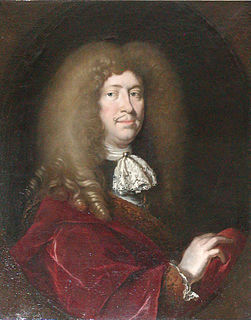
Rasmus Bartholin was a Danish physician and grammarian.

Thomas Bartholin was a Danish physician, mathematician, and theologian. He is best known for his work in the discovery of the lymphatic system in humans and for his advancements of the theory of refrigeration anesthesia, being the first to describe it scientifically.

Caspar Bartholin the Younger, was a Danish anatomist who first described the "Bartholin's gland" in the 17th century. The discovery of the Bartholin's gland is sometimes mistakenly credited to his grandfather.
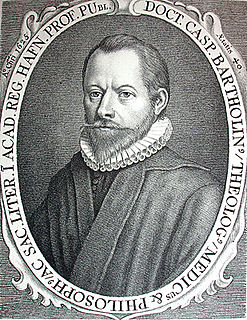
Caspar Bartholin the Elder was a Danish physician, scientist and theologian.

Árni Magnússon was a scholar and collector of manuscripts from Iceland who assembled the Arnamagnæan Manuscript Collection.

The Copenhagen Fire of 1728 was the largest fire in the history of Copenhagen, Denmark. It began on the evening of 20 October 1728 and continued to burn until the morning of 23 October. It destroyed approximately 28% of the city and left 20% of the population homeless. The reconstruction lasted until 1737. No less than 47% of the section of the city, which dates back to the Middle Ages, was completely lost, and along with the Copenhagen Fire of 1795, it is the main reason that few traces of medieval Copenhagen can be found in the modern city.
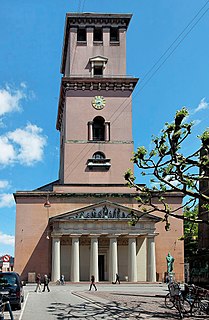
The Church of Our Lady is the cathedral of Copenhagen. It is situated on Frue Plads public square in central Copenhagen, next to the historic main building of the University of Copenhagen.

Peder Hansen Resen was the Danish historian, legal scholar and the president's residence in the city. He was the son of Bishop Hans Hansen Resen.

The Faculty of Law of the University of Oslo is Norway's oldest law faculty, established in 1811 as one of the four original faculties of The Royal Frederick University. Alongside the law faculties in Copenhagen, Lund and Uppsala, it is one of Scandinavia's leading institutions of legal education and research.

Simon Paulli, was a Danish physician and naturalist. He was a professor of anatomy, surgery and botany at the University of Copenhagen. The genus Paullinia is named after him.
Oliger Jacobaeus (1650-1701), also known as Holger Jacobi, was a Danish physician and naturalist. He was professor of medicine, philosophy, history, and geography at University of Copenhagen.
Oliger (Holger) Paulli, also spelt as Olliger Paulli, was a wealthy Danish merchant from an influential family, pamphleteer, religious fanatic, and publisher. He was renowned for his over-zealous activities for the return of Jewish people to their promised holy land.
The Royal Danish Academy of Surgery, or Academia Chirurgorum Regia, was an educational institution which existed from 1785 until 1842 in Copenhagen, Denmark. Its former building at Bredgade now houses Medical Museion, University of Copenhagen's museum of medicine.
Events from the year 1645 in Denmark.
Theatrum Anatomico-chirurgicum was an anatomical theatre which existed from 1736 until 1785 in Copenhagen, Denmark. It was built as a replacement for Domus Anatomica which had been destroyed in the Copenhagen Fire of 1728 and was itself succeeded by the Royal Danish Academy of Surgery.
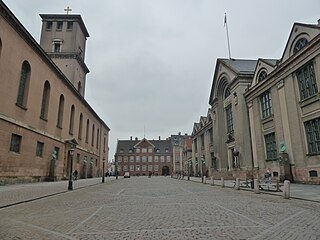
Frue Plads is a public square located on the north side of the Church of Our Lady in central Copenhagen, Denmark. It occupies a rectangular space which is bounded on the other sides by University of Copenhagen's main building to the north, Nørregade to the west and pedestrianized Fiolstræde to the east.
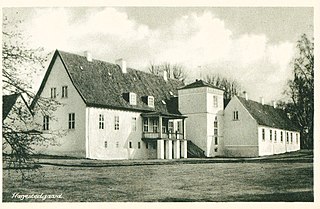
Hagestedgaard is a manor house and estate located at the village of Hagested, near Holbæk, Holbæk Municipality, some 60 kilometres west of Copenhagen, Denmark. The estate traces its history back to the 13th century but the current asymmetrical complex of single-storey, white-washed buildings surrounding a central courtyard was constructed for Hans Didrik Brinck-Seidelin in 1747 with the exception of the remains of a tower built by Johan Friis in 1555. The estate has been owned by members of the Castenskiold family since 1769.

Ved Stranden 8 is a Neoclassical property located at the corner of Ved Stranden and Boldhusgade, opposite Christiansborg Palace, in central Copenhagen, Denmark. The building was listed on the Danish registry of protected buildings and places in 1932.

Christen Willumsen Worm was a Danish theologian and Bishop of the Diocese of Zealand from 1711 until his death.